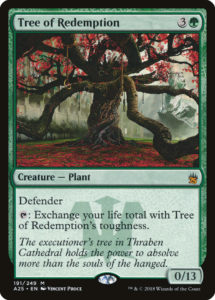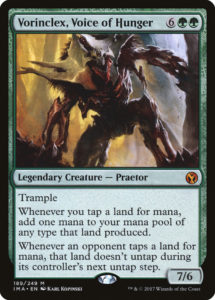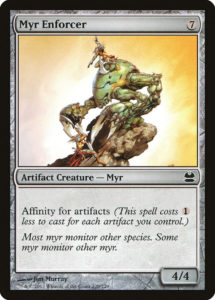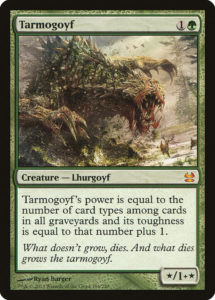Yesterday, Mark Rosewater’s State of Design came out. It’s an annual must-read for design enthusiasts, as Rosewater reviews the successes and shortcomings of the previous year with more candor than you’ll find almost anywhere else in the industry. As ever, he focuses his criticism primarily on design—what he does and knows best. This year, he added something new to State of Design, something I’ve been hoping to see for years:
For the last few years, I just talked about the Standard-legal expansions, but this year, I want to touch on every booster product. For each, I will talk about the highlights and the lessons. Before I get to that though, I’ll start by talking about the year as a whole.
Rosewater covered Ixalan block mistakes, the highs and misses of Dominaria and Unstable (the two smash successes of the last year), and touches upon Battlebond and Core 2019, two sets which he had limited involvement with, if any. But two booster products were conspicuously absent, the two I most wanted to hear Rosewater comment on. I asked MaRo why he’d neglected to comment on Iconic Masters and Masters 25 and quickly received the following response:
Booster products with new content. I think my editor snipped out a few words.
— Mark Rosewater (@maro254) August 20, 2018
That’s a weird requirement to have, but we already got much more breadth than we ever do in State of Design. Moreover, I completely believe that an editor might exclude some seemingly erroneous modifiers. I’m not going to dwell on why he didn’t comment on the Masters line. Still, it’s one of the most personally significant product lines, so I’d like to spend today discussing the future of the Masters line, and why it’s likely in jeopardy.
What happened to Masters?
The Masters product line began with 2013’s Modern Masters, a smash success that couldn’t be found at its MSRP of $7 a booster pack. It was such a big hit, it instantly become a biennial product, intended to come out every two years to help Modern remain an accessible format (and be the format of record-breaking Grand Prixs). 2015’s Modern Masters had less value and a $10/pack price tag, but was still a hit. After that, the Masters line became an annual product with 2016’s Eternal Masters (the first Masters set to focus on formats with both smaller demand and supply than Modern), then immediately became a biannual product with 2017’s Modern Masters 2017 (which reprinted the incredibly necessary Zendikar fetchlands) and Iconic Masters. All of that looked to continue in 2018, but Iconic Masters threw things into disarray.
Iconic Masters failed to hit the mark. The set’s price tag wasn’t justified by the cards within it—cards like Mana Drain and Flusterstorm were expensive because they had small supply—their comparatively small demand tanked their prices, making packs hardly worth the $10 price point. Sure, the set had a host of solid reprints, but not enough to get people to pay $50 for a draft. HasCon, while a ton of fun, fully spoiled the set, giving the market two months to react to the increased supply before the supply actually increased. Even the set’s name, which suggested a strong focus on iconic creature types or card combos, set incorrect expectations (one of the biggest lessons of the year, according to yesterday’s State of Design). Whereas the worst-performing Masters products could be found at slightly below MSRP (I think EMA was frequently available for $185 a box), Iconic Masters was easily obtained at $135 a box, making it a toxic commodity for stores who likely have to sell it at a loss to this day.
Earlier this year, in an article with the same title, Gavin Verhey discussed the present and future of Masters sets:
…I know there are other factors about [Iconic Masters] many of you didn’t find quite as great. Many players felt like the cards inside weren’t as exciting as they had originally hoped, which is important to the collectors, the drafters, and those who like to do both. The name was misleading, as we intended for “iconic” to indicate iconic creatures, but—especially coming up on our 25th anniversary—it was widely interpreted by players to mean historically iconic cards. The early preview at HASCON, while very cool for the people there, meant a lot of the excitement around the set had evaporated by the time it was released. And to top it all off, it was releasing at a very busy time of the year, right next to the highly anticipated Unstable.
I’ve read through pages and pages of feedback on the set, and talked to countless stores and players about Iconic Masters both in person and online. I cannot stress enough that this is something I really, truly care about. If you weren’t happy with Iconic Masters, on behalf of the team, I would like to apologize. With everything we do in R&D, we’re always learning from our experiences to make the next set as great as possible.
And I have some good news.
Masters 25 is the themed Masters set you’ve been waiting for.
This is the set full of exciting, iconic cards. You get to wield nostalgic reprints from literally every black-bordered set in Magic. You’ve already seen Jace, the Mind Sculptor—and there are plenty of other saucy reprints inside.
To clarify the theme: what you’re going to see in this set, precisely, is a theme of nostalgia and history. We picked many cards, especially at common and uncommon, that should conjure up memories. I know playing with some of these cards again simultaneously gave me flashbacks to sitting on my carpet at home casting unsleeved spells with my brother, building decks for my first Friday Night Magic events, all the way through competing on the Pro Tour. No matter how long you’ve been playing Magic, you’ll find cards to remember here.
Masters 25 was hyped, had some much-needed reprints, gorgeous new artwork, and the shockingly beautiful and nostalgia-inducing watermarks. It was the beginning of a new era of themed Masters products, designed less for the enfranchised Limited-obsessed and Modern-inclined audiences and more for broader audiences like Commander players, Cube creators, and perhaps Pauper and Brawl lovers. Unfortunately, Masters 25 seems to have flopped, with boxes easily available for $145, only slightly higher than Iconic Masters’ unprecedented low.
Where is Masters?
The Masters line is in rough shape, but that doesn’t change how much I’ve loved previous installments. MMA2013 is among the best draft formats I’ve ever played, and GP Vegas my favorite events I’ve attended. I wasn’t loving how frequently Masters products were releasing ($50 a draft is expensive enough when it happens every two years and there’s a GP to prep for, but twice a year and for no event is both too expensive and hard to justify), or the switch to themed products, but I still would give it a shot. But the next Masters product hasn’t been announced, and given Magic’s timeline, is unlikely to come out this year.
2018, Magic’s anniversary year, is interesting. We’ve gone from two years of too many large product releases (the summers of 2016 and 2017 and winter of this past year were overstuffed with products that ended up competing with each other), to a year of many smaller, experimental products but fewer major releases. There’s hardly anything in the second half of the year: Dominaria released in April, Battlebond, Signature Spellbook, and Global Series (an innovation draft product and two new products for new audiences) released in June, followed by the new Core Set. The last five months of year have only two big products: the annual Commander release and the annual Fall expansion, Guilds of Ravnica. This might be an overreaction to the problems of the past two years, a consequence of WotC’s new three-team pipeline’s growing pains, or perhaps a consequence of the focus on smaller, more agile teams working on smaller, more focused products. Whatever the cause(s), it looks like the Masters line is on hold at the moment.
What does Masters need?
Masters is in rough shape, but I don’t believe it’s unsalvageable. I think consumer and LGS confidence in the product line is perhaps at an all-time low. I know of only two kinds of LGS in NYC: those that breathed a huge sigh of relief for underbuying IMA and M25 compared to previous Masters products, and those that have been slowly trying to offload the past year’s Masters boosters. For Masters to return, I think a few things could be a big boon:
1. Pack the set with value
This is kind of a no-brainer, but having mythic rares like Tree of Redemption cannot fly in a premium product. Heck, even cards like Comet Storm, which are bonkers in Limited but never held a premium price point, are hard to accept in a $10 a pack product. Moreover, a substantial portion of the set’s value needs to be in Commander or Modern staples, since those are the largest audiences who play sanctioned, nonrotating formats. Which brings me to my second point…
2. Make it a Modern Masters
I accept that the product line had to expand. It was successful, it excites many more audiences than just Modern players, and an MMA coming out more often than every two years wouldn’t have enough new content to go on. But the best Masters products thus far have all been Modern Masters. Instead of branching out into unknown territory (which Wizards seems to be constantly and correctly doing for smaller, experimental products), why not followed the proven track record of success? I know that this may sound like me just asking for what I want, but there’s nothing wrong with making a product for an audience that’s already proven not only to exist, but to want to buy the product. What better way to convince stores that they should in fact stock a Masters product than to make it one of a family of products that have sold well in the past?
3. Consider the price point
$10 is a lot per pack. You know it, I know it. There’s good reason for Wizards to charge extra for boosters packed with money and avoid heavily devaluing peoples’ collections (Magic is a collectible card game, after all). There’s something to be said for paying a price premium for a premium product. But a $30-$50 draft is a huge ask, when the price of booster packs and booster drafts have not changed in a decade? (Seriously, back in 2010, when I returned to the game, booster packs were $3.99 and booster drafts were $15, the same as they are today.) However, if Masters lines are going to be printed more heavily and we’ve already seen some of the most valuable cards in Modern reprinted—like Tarmogoyf, Snapcaster Mage, and Mox Opal—then it could be time to return Masters pricing to 2013 levels.
4. Complexity, Nuance, and Power
This is ultimately what brings me back to Masters products. It’s not just the value, but the sheer joy of playing with powerful cards, sweet archetypes, and discovering how new contexts can drastically change card evaluations. Masters 25 felt rather soupy because it was basically defined by two-card combos. Sure, there was a lot to discover; but if you weren’t a Jenny/Spike who loves finding more and more interactions (which I’m not), the set felt pretty hollow. Iconic Masters had power, but there’s only so much to discover in a set with so few (and often simple) archetypes and so many core set cards. Heck, Masters 2017 was fun, but there’s only so much depth to a format where the correct choice is almost always to take fixing and play the best cards (a warning to all the cube designers out there—rainbow is fun, but it can’t be the always-best thing to do in a balanced cube). I want more Masters products with overt, powerful archetypes and some wiggle room between them. I want MMA2013, or even MMA2015 or EMA again.
When done well, the Masters product line is a stabilizing, invigorating force for Magic. It made Modern, once a fledgling format replacing Extended, into one of Magic’s biggest and most popular Constructed formats today. It is a boon to enfranchised drafters, providing rich and satisfying environments that reward skill with some of the most valuable booster prizes around. It gives people a means to play the lottery and dip their toes into a format before diving in. It drops the prices of cards that are unconscionably high (remember when Tarmogoyf was on track to be $200?) and doesn’t tank the value of cards that are in high demand (see Mox Opal, Liliana of the Veil, Karn Liberated, Cavern of Souls, and basically every Modern chase mythic that’s only been printed once).
The Masters line had some major missteps this year which I was I could have read MaRo detail. It was overprinted, overpromised, and undervalued. It set incorrect expectations. It was brought back too quickly and too often. It eschewed clear archetypes for more nebulous themes. It hurt local game stores. But the damage is not too severe. I suspect that a Masters product for Fall 2019 was either cancelled or postponed (if the past few years’ precedent were followed, we’d be in the middle of spoiler season right now for a late Summer Masters product to tide over folks until Guilds of Ravnica releases). This was likely a good choice as the next Masters product needs to knock it out of the park.
Well, here’s hoping it does. I really, really want to play and love Masters sets again. (Hopefully at a GP.)
And, as always, thanks for reading.
—Zachary Barash
Zachary Barash is a New York City-based game designer. He designs for Kingdom Death: Monster, has a Game Design MFA from the NYU Game Center, and does freelance game design. When the stars align, he streams Magic.
His favorite card of the month (and all time) is Prophetic Prism. It’s quintessentially fair, enormously powerful, and allows incredible greed at a reasonable cost (but little opportunity cost). Also, every version of its art is unspeakably beautiful.





